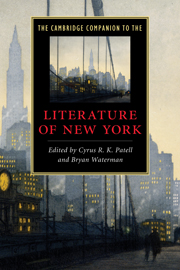Book contents
- Frontmatter
- Introduction
- 1 From British outpost to American metropolis
- 2 Dutch New York from Irving to Wharton
- 3 The city on stage
- 4 Melville, at sea in the city
- 5 Whitman’s urbanism
- 6 The early literature of New York’s moneyed class
- 7 Writing Brooklyn
- 8 New York and the novel of manners
- 9 Immigrants, politics, and the popular cultures of tolerance
- 10 Performing Greenwich Village bohemianism
- 11 African American literary movements
- 12 New York’s cultures of print
- 13 From poetry to punk in the East Village
- 14 Staging lesbian and gay New York
- 15 Emergent ethnic literatures
- Epilogue: Nostalgia and counter-nostalgia in New York City writing
- Further reading
- Index
- Series list
Epilogue: Nostalgia and counter-nostalgia in New York City writing
from 15 - Emergent ethnic literatures
Published online by Cambridge University Press: 28 November 2010
- Frontmatter
- Introduction
- 1 From British outpost to American metropolis
- 2 Dutch New York from Irving to Wharton
- 3 The city on stage
- 4 Melville, at sea in the city
- 5 Whitman’s urbanism
- 6 The early literature of New York’s moneyed class
- 7 Writing Brooklyn
- 8 New York and the novel of manners
- 9 Immigrants, politics, and the popular cultures of tolerance
- 10 Performing Greenwich Village bohemianism
- 11 African American literary movements
- 12 New York’s cultures of print
- 13 From poetry to punk in the East Village
- 14 Staging lesbian and gay New York
- 15 Emergent ethnic literatures
- Epilogue: Nostalgia and counter-nostalgia in New York City writing
- Further reading
- Index
- Series list
Summary
In the mid-1940s, the New Yorker writer Joseph Mitchell created a 93-year old resident of the South Street Seaport named Hugh G. Flood - not quite antediluvian and not quite postdiluvian, either. He was a “tough Scotch-Irishman,” a composite of “several old men” Mitchell knew from the Fulton Fish Market. The “truthful rather than factual” sketches Mitchell wrote about Mr. Flood were “stories of fish-eating, whiskey, death, and rebirth.” The title character, an inveterate consumer of freshly imported seafood, dispenses wisdom on topics such as the medicinal properties of oysters (including where to find the best ones in lower Manhattan and Brooklyn) and complains that scientists have ruined the most basic foods (he gives Mitchell's narrator the inside scoop on where to find a decent, old-fashioned loaf of bread on Elizabeth Street). Like Mitchell's other writing for the New Yorker, these stories featured people and places representative of older, threatened, but persistent remnants of the city's past. Mitchell's Mr. Flood is a “retired house-wrecking contractor,” a participant in the never-ending capitalist ritual of tearing things down to put new things up: “creative destruction,” as the economist Joseph Schumpeter, a contemporary of Mitchell's, put it.
- Type
- Chapter
- Information
- The Cambridge Companion to the Literature of New York , pp. 232 - 240Publisher: Cambridge University PressPrint publication year: 2010
- 1
- Cited by



